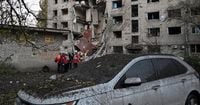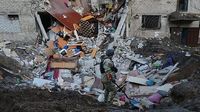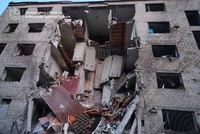As Ukraine braces for another harsh winter, the country has been rocked by one of the most intense waves of Russian drone and missile attacks on its energy infrastructure since the start of the full-scale invasion nearly four years ago. On the night of October 29 into the morning of October 30, 2025, Russian forces unleashed a barrage of over 650 drones and more than 50 missiles, targeting power plants, transmission lines, and civilian infrastructure across nearly every region of Ukraine. The attacks left a trail of destruction, causing widespread power outages, killing at least six people—including a seven-year-old girl—and injuring dozens more, many of them children.
According to the Associated Press, Ukrainian Prime Minister Yulia Svyrydenko described the relentless strikes as “systematic energy terror,” a campaign aimed at plunging the country into darkness just as bitter winter temperatures set in. “Russia continues its systematic energy terror — striking at the lives, dignity, and warmth of Ukrainians on the eve of winter. Its goal is to plunge Ukraine into darkness; ours is to keep the light on,” she said. Svyrydenko called urgently for more air defense systems, tougher sanctions, and maximum diplomatic pressure on Moscow, underscoring the need for international support to defend Ukraine’s battered energy grid.
The scale and coordination of the assault were unprecedented, with Ukrainian Air Force officials reporting that from 19:00 on October 29, Russia launched a complex combined aerial attack involving 705 total air threats: 653 drones and 52 missiles of various types. These included the notorious Shahed and Gerbera drones, Kalibr and Iskander-K cruise missiles, as well as aeroballistic and guided aviation missiles. Ukrainian air defenses managed to intercept or suppress 623 of these threats—a remarkable feat, given the sheer volume and diversity of the attack. However, as President Volodymyr Zelenskyy acknowledged, “Many were shot down, but unfortunately, there have been hits.”
The brunt of the devastation was felt in the southeastern region of Zaporizhzhia, where five apartment buildings and several private homes were destroyed or badly damaged. Local authorities, cited by Euromaidan Press, confirmed that two people were killed in the city, including a 62-year-old man whose body was identified by his sister at the scene. Seventeen others were injured, among them six children. Fires broke out in residential areas, and infrastructure facilities were struck, prompting a criminal investigation for war crimes. “People have acute reactions to stress, wounds, concussions, bruises and fractures,” said Ivan Fedorov, head of the Zaporizhzhia regional administration.
Elsewhere, the attacks caused similar havoc. In the central-western Vinnytsia region, a seven-year-old girl was critically wounded and later died in hospital from her injuries, according to regional governor Nataliia Zobolotna. In the eastern city of Sloviansk, three people—a woman and two men—were killed in a rocket strike, as reported by the local police and military administration. Across all regions, at least 18 people, including children aged 2 to 16, were injured.
The onslaught was not limited to civilian homes. Ukraine’s centralized public infrastructure—responsible for water, sewage, and heating—was also targeted, compounding the hardship for millions. The Ministry of Energy announced nationwide restrictions on electricity supplies to both retail and industrial consumers. In some areas, water and heating services were interrupted, a serious concern as the country prepares for another winter under siege. DTEK, Ukraine’s largest private energy company, reported that its thermal power stations in several regions were under attack, while two major energy infrastructure facilities in the western Lviv region, close to the Polish border, were damaged.
The ripple effects of the attack were felt beyond Ukraine’s borders. The Polish military, concerned about the proximity of Russian missiles and drones, scrambled both Polish and allied NATO aircraft as a preventive measure. Regional airports in Radom and Lublin were temporarily closed to ensure the military’s freedom of operation, according to the Polish Air Navigation Services Agency. The incident underscored the ongoing risk of escalation and spillover into neighboring NATO countries.
Beyond the immediate casualties and damage, the strikes have had a profound impact on daily life across Ukraine. In Dnipro, power outages forced Ukrainian Railways to switch to backup locomotives, delaying at least 11 passenger trains. In Odesa Oblast, a strike on an energy facility injured a worker and left nearly 27,000 homes without power, though critical infrastructure was quickly restored using backup generators. In Lviv and other western regions, authorities introduced hourly shutdown schedules and scrambled to repair damaged facilities, determined to keep the heating season on track despite the setbacks.
President Zelenskyy, in his address following the attacks, condemned the assault as a continuation of Russia’s “terrorist war against life.” He called for increased pressure on Moscow, including sanctions targeting the oil, gas, and finance sectors, as well as secondary sanctions against those who sponsor the war. “Ukraine expects the United States, Europe, and G7 countries not to ignore Moscow’s intent to destroy everything,” Zelenskyy said, according to Euromaidan Press.
While Moscow has denied targeting civilians, claiming its strikes are responses to Ukrainian attacks on Russian infrastructure, the pattern of destruction—particularly the repeated targeting of energy facilities and residential neighborhoods—has drawn widespread condemnation. Months of attacks have aimed to erode Ukrainian morale and disrupt weapons manufacturing and other war-related activity, but as the President of the European Bank for Reconstruction and Development, Odile Renaud-Basso, told Euronews, the pounding of Ukraine’s energy grid poses a “new challenge” for the country this winter. The EBRD has stepped up investments in Ukraine since the invasion, sending more than €8.3 billion to support reconstruction and resilience, but the scale of the damage remains daunting.
Despite the devastation, Ukrainian officials remain defiant. “Its goal is to plunge Ukraine into darkness. Ours is to preserve the light,” Prime Minister Svyrydenko declared. As the country braces for another winter of war and blackouts, the resilience of its people—and the continued support of its allies—will be put to the test once again.
With the latest wave of attacks, the stakes have never been higher for Ukraine’s energy security and civilian morale. The coming months will reveal whether the country can withstand this campaign of “systematic energy terror” and keep the lights on against the odds.






